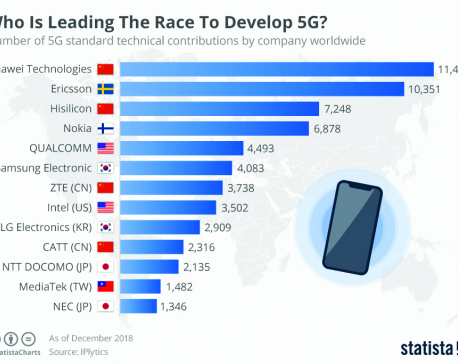
OR


Ved P Kafle
The author is a research manager of new generation network technologies at the National Institute of Information and Communications Technology, Tokyonews@myrepublica.com
More from Author
Fifth generation technology is expected to connect various elements of smart transportation system such as traffic lights, roadside signs and symbols, CCTV cameras etc
The fifth generation (5G) mobile communication technology is maturing as its research, development and global standardization work is progressing rapidly. Telecommunication equipment manufacturers such as Huawei, Samsung and Qualcomm have announced their 5G products. Similarly, giant network operators in developed countries and China are planning to start deploying 5G services on a massive scale from 2020.
Understanding 5G
While reporting about 5G, media usually describe only one feature of “high speed” in comparison with its forerunner 4G without mentioning its other equally important features. Actually, 5G brings many more advantages than just speed. Unlike the current 4G network, which mainly provides connectivity for human-centric communications, 5G network also provides machine-centric communications to usher in a new era of the Internet of Thing (IoT) and provide highly reliable connections to emerging mission-critical services such as autonomous vehicles.
According to the International Telecommunication Union—a UN agency that facilitates international connectivity in communications networks by developing technical standards and administrating the global radio spectrums and satellite orbits, which also refers to 5G technology as International Mobile Telecommunication for 2020 or IMT-2020—5G services can be broadly grouped into three usage scenarios: enhanced mobile broadband, ultra-reliable and low latency communications, and massive machine-type communications.
If these terms look too technical, consider them to mean streaming of high definition video on mobile phones, highly reliable connections, and connecting everything.
To support these usage scenarios, 5G network is coming up with enhanced key capabilities of data rate, connection density, latency, and energy efficiency, which are 10 times better than 4G. 5G connectivity is expected to provide the peak data speed of 20 gigabits per second in best coverage areas and minimum of 100 megabits per second everywhere for each connected device. It can connect one million devices in the area of every square kilometer. The transmission and propagation delay in radio network is reduced to only one millisecond. The high data rate, low delay and highly dense communications collectively make 5G technology instrumental for the realization of new services as augmented and virtual reality (AR/VR), self-driving cars, telemedicine, remote surgery, smart transportation, smart agriculture, factory automation, home and building energy management.
5G breakthroughs
Realization of self-driving cars is the next unprecedented breakthrough of information and communication technology. 5G technology is expected to connect various elements of smart transportation system such as traffic lights, roadside signs and symbols, CCTV cameras, cars and devices of traffic police or regulation authority. A self-driving car itself contains numerous sensors and cameras and produces a huge amount of data—one to four Tera Bytes per day—which is equivalent to the volume of data currently used by 2,666 Internet users (note that data transmission speed is measured in bits per second while the volume of data is in Bytes, 1 Byte = 8 bits). It can transmit this volume of data in realtime to 5G network and obtain navigation guidance instantly from the network. Self-driving car service providers (also referred to as Over-the-top or OTT industry) deploy artificial intelligence capabilities over 5G to process the data to identify obstacles in the road and generate safe navigation path for the car.
Another notable application that 5G makes possible is telemedicine and remote surgery with the help of nano robots. 5G’s highly reliable and low latency communications would enable a specialist doctor located in a city to operate a nano robot inserted in a patient’s body in a distant hospital. The realtime continuous control of nano robots ensures that they operate precisely as planned and do not harm the patient at all.
5G can help in precision farming by continuously monitoring soil and weather conditions such as wetness, acidity, temperature, and light remotely through the deployment of connected sensors in fields and making informed decision about planting suitable crops and their timely care. It can also be useful to operate agriculture instruments such as cultivator, planter, and harvester remotely, thus increasing their efficiency and relieving farmers from adverse outdoor weather conditions.
Many tend to think 5G services are going to be very expensive because of the added benefits. However, that is not the case because 5G networks are deployed by using the innovative concept of network virtualization that enables using general purpose mass-produced cheaper hardware, which can be segmented into many isolated virtual machines by software. 5G network functions are installed in virtual machines and upgraded at any time, thus making the network equipment cheaper.
Traditionally, hardware and software are tightly bundled together in networking equipment by manufactures, and the equipment is very expensive compared to general computer servers being produced in mass by several manufactures. It is very difficult, if not impossible, to upgrade the traditional equipment with new advanced network software developed by other companies. 5G will overcome this limitation through the introduction of network virtualization. The virtualization together with the capability of software-defined networking would automate network operation and management functions, thus reducing the requirement of involving skilled human resource 24 hours a day and greatly saving the operation expenses.
Network virtualization enables the on-demand adjustment of network equipment’s capability such as computation power, memory size, storage disk space and transmission speed, called bandwidth, by software as the number of active users fluctuates. This fine-grained monitoring and control of network equipment, possibly by using AI, makes 5G networks capable to provide guaranteed quality of user experience all the time. It also enables smarter management of electric power consumption.
Other new features of 5G are that they use new radio standards for both below 6 Giga Hertz bands and millimeter wave bands such as 28 GHz and 60 GHz to provide very high speed data transmission. As the new radio signal attenuates very quickly, 5G network requires deploying much larger number of base stations than 4G. However, mass production of micro base stations would make the per unit price cheaper. And as the base station occupies less space, it costs less money for renting the space. Additionally many more terminals use a 5G base station, further lowering the cost. Interestingly, 5G will integrate both terrestrial base stations and satellites for increasing coverages to remote and isolated areas such as mountains and seas.
The author is a research manager of new generation network technologies at the National Institute of Information and Communications Technology, Tokyo
ved.kafle@gmail.com
You May Like This

Risky tech attraction
Technology alone cannot encourage democracy. To some extent, high-quality, responsible journalism can ... Read More...

Infographics: Who is leading the race to develop 5G?
The tension over 5G technology between Chinese telecommunications company Huawei and the United States has reached a variety of low... Read More...

Fixing Afghanistan’s peace
Peace is possible in Afghanistan. But the Afghan government and the US need to be realistic about the process and... Read More...







Just In
- NRB to provide collateral-free loans to foreign employment seekers
- NEB to publish Grade 12 results next week
- Body handover begins; Relatives remain dissatisfied with insurance, compensation amount
- NC defers its plan to join Koshi govt
- NRB to review microfinance loan interest rate
- 134 dead in floods and landslides since onset of monsoon this year
- Mahakali Irrigation Project sees only 22 percent physical progress in 18 years
- Singapore now holds world's most powerful passport; Nepal stays at 98th











Leave A Comment